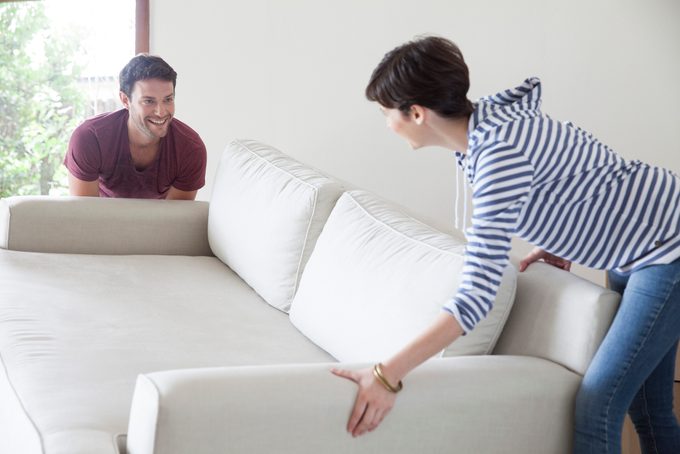Feng Shui for Your Home: A Guide
Updated: Dec. 01, 2023

Exploring the person-place connection — and better design — with the principles of feng shui, according to an expert.
Most people have heard of feng shui, or at least read something about it. Some feng shui books are tough reads, dense and academic in tone. Joan Kaufman, a certified interior designer and founder of Interior Planning & Design Inc., describes it more plainly: A philosophy that explores the person-place connection.
“That’s what we start with,” she says. “How do you experience your space? How does it affect you? It does impact you, drastically. We know when we’re in a space we feel good in, and that’s what feng shui comes down to. How do you use your space to support yourself?”
On This Page
What Is Feng Shui?
According to Kaufman, certified by the Feng Shui Institute of America as a practitioner, feng shui (pronounced “fung shway”) is a 3,000-year-old philosophy and environmental science. The Chinese developed it after watching animals interacting with their environments.
“Everyone is busy right now,” Kaufman says. “Today’s lifestyle leaves us with little time to contemplate our surroundings. [The] coronavirus was an eye-opener for many people. Our homes looked like offices and vice versa.”
This, she says, sent design-savvy homeowners and interior designers into overdrive trying to warm up their homes during the pandemic. These efforts ranged from kitchen and bath design to wall coverings and paint colors.
What Does Feng Shui Actually Mean?
It literally translates to wind-water. It focuses on how the environment affects your life, inside and out.
Feng shui concerns itself with how we’re interwoven with nature, and how the elements of nature and the environment, when in balance, lead to harmony and well-being. This can be different for every person.
How to Feng Shui a Space

There are five basic steps:
Step 1: Determine the ‘why’
The WHY is your everything, Kaufman says. “It drives what you’re doing,” she says. “The what is less important than the why.”
Ask yourself: Is the change for a crisis? Life change? Relationship issue? Just tired and want a change? It all starts with this self-assessment.
Step 2: Map out your plan
The bagua, a series of eight symbols that represent reality and the elements, are the core of the space planning portion of the process.
Kaufman says she practices “pyramid feng shui,” which acknowledges space planning is different if you exist in a different hemisphere than China. The bagua is essentially a magic square — a grid of nine smaller squares that help you plan your space. It begins at your doorway or the entrance to the room you want to change.
“In China, they do this planning based on the compass,” Kaufman says. “In the U.S. it’s more about how we live and what we do — enhancing what you want, diminishing what you don’t, and acknowledging the role of the individual. No two people are the same.”
Step 3: Examine the five elements
Like many other philosophies and cultures, feng shui is based on the circle of life, an interwoven series of relationships based on five elements: air, water, fire, earth and metal.
“The seed germinates in water and grows to become a tree,” Kaufman says. “The tree is wood, which matures and burns in a fire. It returns to ash and the ash returns to the earth, which over time becomes metal. And water flows over it all, washing it and smoothing it.”
Phrases like “red-hot rage” or “down to earth” refer back to these elements and often represent the most logical solutions to a problem you’re trying to solve. Feeling stressed and angry? One design option incorporates the soothing hues of water into your space. Exhausted or unmotivated? Light a fire with warmer colors, or enhance your fireplace.
Step 4: Clear the clutter
Sometimes this step comes first, Kaufman says. But if not, this is the time to do it.
“Clutter blocks energy and your mind. It’s not good for you,” she says. “Somehow through the process of clearing the clutter, things come into tune much better.” By decluttering, energy can change and flow naturally.
Step 5: Adjust
Adjust your qi (or ch’i). “This is the energy of the space,” Kaufman says.
This often gets to the heart of what people think of as feng shui. By balancing the elements and adjusting furniture, color and other aspects of a room to maximize the flow of energy, you’ve achieved a space that looks and feels right for your needs.
Additional Feng Shui Wisdom
Keep these three concerts in mind.
You don’t have to do this alone
Lots of interior designers work within some form of feng shui. Or you can find a specific practitioner, take a seminar or hire someone to handle it for you.
Kaufman says if it feels overwhelming, something is wrong. Keeping it simple is better than making it too technical. And remembering it’s practical and logical, not woo (nonsense). “People shouldn’t be afraid of it,” she says. “You can totally learn it.”
It’s not permanent
“It’s a daily practice — not a one and done,” Kaufman says. “I can’t feng shui somebody, but I can facilitate feng shui within their own environment. It’s knowing yourself, which is a journey that never ends. Where you are today will be different in a year because you’re making changes and hopefully growing. It’s a continual process.”
Harmony in your space increases your well-being
In feng shui, we’re at the center with spokes coming out, like a wheel. “Good feng shui practice can eventually lead you to other things: eating healthy, surrounding yourself with healthy products,” Kaufman says. That can include other practices like yoga and Pilates.
